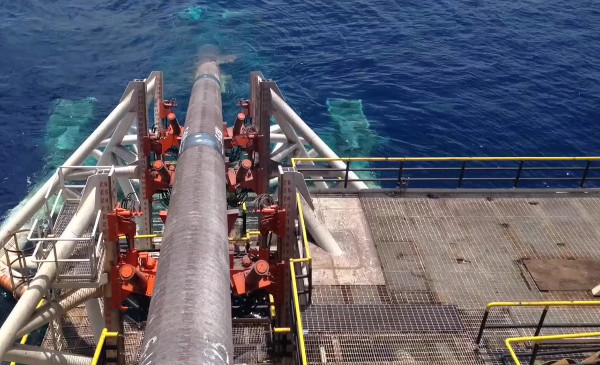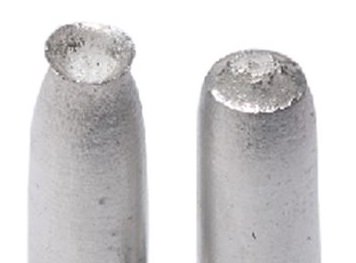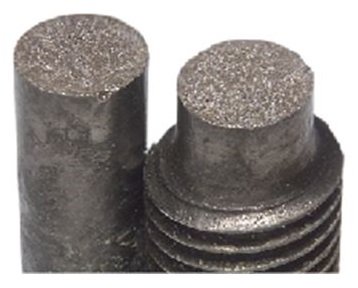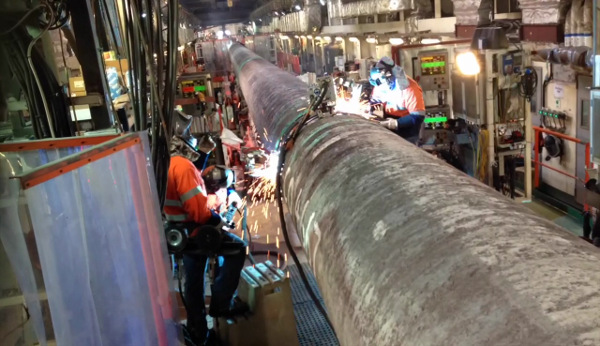WelderDestiny › Welding Engineering Tools › Fracture Mechanics
Fracture Mechanics
Fracture mechanics is the study of how stresses, material properties and material defects interact and lead to failure of the structure or component under consideration. This is particularly important in welds, as welds are typically the place where defects (or rather discontinuities) are most prevalent.
The WelderDestiny Compass: Weekly e-zine Subscription
You can take a look at "The WelderDestiny Compass" back-issues by clicking here.
On
this page we will take a very high level look at what fracture mechanics is. It
is not the intention to go into enough details to allow you to actually do the
calculations. It is the intention that you understand the principles, so that when
you are confronted with requirements to test the fracture toughness properties
of welds and also have to apply defect acceptance criteria to welds, you
understand why this is important.
 A Subsea Pipeline Leaving the Back of a Laybarge: Subsea pipelines are typically designed using fracture mechanics principles.
A Subsea Pipeline Leaving the Back of a Laybarge: Subsea pipelines are typically designed using fracture mechanics principles.Ductile and Brittle Materials
Most
people will instinctively understand that some materials are brittle, while
other materials are ductile. As an example, ceramics such as those our fine
china tea cups are made from, are very brittle. If we drop the tea cup it is
likely to break in a brittle fashion, or if we knock the rim of the cup it is
likely to “chip”. We all instinctively understand that a ceramic tea cup is
“brittle”. We also know that a steel pot when dropped does not break in a
brittle way. It may dent, but not break. We would describe the steel pot as
being “ductile”.
So,
from a fundamental engineering perspective, what makes one material seem
brittle and another seem ductile? To answer this question, let us think of a round
steel bar (say 10mm diameter) being loaded in tension. Initially the steel bar
will become longer without experiencing a permanent deformation. In other
words, if we removed the load, the steel bar will go back to its original
length. We call this “elastic deformation”. If we kept loading the bar even
higher, then a point is reached where the bar starts to deform permanently. In
other words, when we remove the loading, the steel bar will not go back to its
original length. It has been permanently elongated. This permanent deformation
is known as “plastic deformation”.
If
we keep loading the steel bar even more, then we will see that the bar
experiences more and more plastic deformation until a point comes when it
breaks. It is important to note that the steel bar not only becomes longer due
to the plastic deformation, but the diameter also becomes smaller. This is
obvious, because if this did not happen, then we would end up with more
material (A greater volume.) than we started with, which would be an
impossibility. (There are circumstances where we can get volume changes, but
for our current discussion these are not relevant.)
In
the case of a ceramic, if we did the same test as with the steel bar above,
then we would have a small amount of elastic deformation, but it would fracture
before plastic deformation sets in. In essence then, ductility is a measure of
how much plastic deformation takes place before fracture occurs. When there is
very little plastic deformation before fracture occurs, then we would call the
material “brittle”.
Some materials
such as steel undergo ductile to brittle transitions when the temperature is
reduced enough. As an example, a normal structural steel will be very ductile
(greater than 20% elongation before failure) at 20°C, but will break in a
brittle manner (almost 0% elongation before failure) at minus 100°C. While this
temperature dependency of metals’ properties is very important, please
understand that this is not primarily what we will be talking about in the
following discussion.
 Ductile Fracture: Note thinning of material and the "cup and cone" nature of the surface. Ductile Fracture: Note thinning of material and the "cup and cone" nature of the surface. |
 Brittle Fracture: Note that there is very little deformation of the material. The fracture surface is very flat. Brittle Fracture: Note that there is very little deformation of the material. The fracture surface is very flat. |
When Ductile Materials Appear Brittle
We
have seen that when a ductile material starts to elongate plastically in one
direction, it contracts in the other dimensions. (Bar becomes longer, but
diameter becomes smaller.) If we manage to restrain the material so that it is
unable to contract in the other two directions, (we prevent the diameter from
becoming smaller) then plastic deformation in the first direction becomes
impossible. The material will therefore keep experiencing elastic elongation,
but instead of then experiencing plastic elongation, the material will break in
what appears to be a brittle manner.
This
type of thing happens when very thick materials are loaded in a manner that
restrains the material from deforming plastically under high loads.
Furthermore, when we introduce localized defects such as crack like defects,
then the loading around the edges of these “sharp” defects tend to introduce
local stress raisers. The material around these stress raisers will experience
stresses above the yield stress, meaning that plastic deformation should
result, but because of the geometry of the material and defect, the material is
restrained, reducing the ability for the plastic deformation to occur. The
material will then fail in what appears to be a brittle manner at some point.
Fracture
mechanics is the study of how materials under such circumstances tend to fail.
If a material fails while absorbing a lot of energy, then the material is said
to be “tough”, while a material that fails while absorbing little energy will
be considered “brittle”. As welding professionals, we are concerned with
providing welds that display the required level of toughness. This can be
measured by tests such as the Crack Tip Opening Displacement (CTOD) test.
The Role of Defects in Welds
In
essence we understand that all welds contain discontinuities. Fracture
mechanics gives us the information to understand what minimum toughness (material
property) is required for a given stress state, when a specific type of
discontinuity is present. The tougher a material, the larger the discontinuity
that can be tolerated. In short then, fracture mechanics is a study of the
interaction of:
- The stresses that a component is exposed to: These stresses typically include applied stresses and manufacturing induced residual stresses.
- The defects present in the component: Generally, this will be in the form of maximum allowable discontinuity sizes that is picked up by non-destructive testing. (NDT Acceptance criteria.)
- The material properties of the component: These are typically the strength and toughness properties of the material.
Practically
the way this is used is for the equipment designers to perform calculations of
the maximum stress anticipated for the equipment, and then specify the maximum
defect sizes allowable (acceptance criteria for NDT) and the minimum material
properties to be achieved in the welds.
We,
as the welding people, need to make sure that we meet the material property
requirements and the defect acceptance criteria for the welds. This means that
where a fracture mechanics approach has been used, the material properties are
measured during the welding procedure qualification process, and the welds are
monitored with the necessary NDT to make sure that the acceptance criteria are
met.
 Welding on Subsea Pipeline in Laybarge: Subsea pipelines are typically designed according to fracture mechanics principles.
Welding on Subsea Pipeline in Laybarge: Subsea pipelines are typically designed according to fracture mechanics principles.Reasons to Use Fracture Mechanics
Please
note that not all components are designed using a fracture mechanics approach.
Often more traditional design methodologies are used that rely on “workmanship”
defect acceptance criteria. These workmanship criteria are based on historical
norms of what has worked well in the past.
Why
then is fracture mechanics used, when it is quite possible to perform designs
without the use of fracture mechanics? Fracture mechanics is typically used
when:
- Conventional design methods result in components that are not economical: Sometimes the more traditional design methods rely on large “factors of safety”. This means that we may end up with something like a pipeline that is very thick, making it very expensive to build. The use of fracture mechanics may enable us to build much more economical components or structures.
- We would like to accept larger weld defects: Under some circumstances it may be difficult to consistently meet the “workmanship” NDT acceptance criteria, without resorting to a lot of repairs. Especially in circumstances where delays caused by defect repairs are very expensive, (e.g. Laying subsea pipelines from a lay barge.) a fracture mechanics calculation may indicate that we could accept significantly larger defects. Often this type of assessment is called an Engineering Critical Assessment. (ECA)
- Defects have been found that is difficult to fix: Sometimes components have developed defects during service. (e.g. A fatigue crack has developed.) When these defects are found, we need to decide if we must fix the defect, or if we can continue operating the equipment with the defect in place. Often this is termed a “fitness for service” (FFS) study.
Please note that in our exploration of fracture mechanics, we did not go into any of the actual design calculations or processes. It has merely been an exercise in understanding fracture mechanics from a fundamental perspective, and its place in welding.
WelderDestiny › Welding Engineering Tools › Fracture Mechanics
The WelderDestiny Compass: Weekly e-zine Subscription
You can take a look at "The WelderDestiny Compass" back-issues by clicking here.